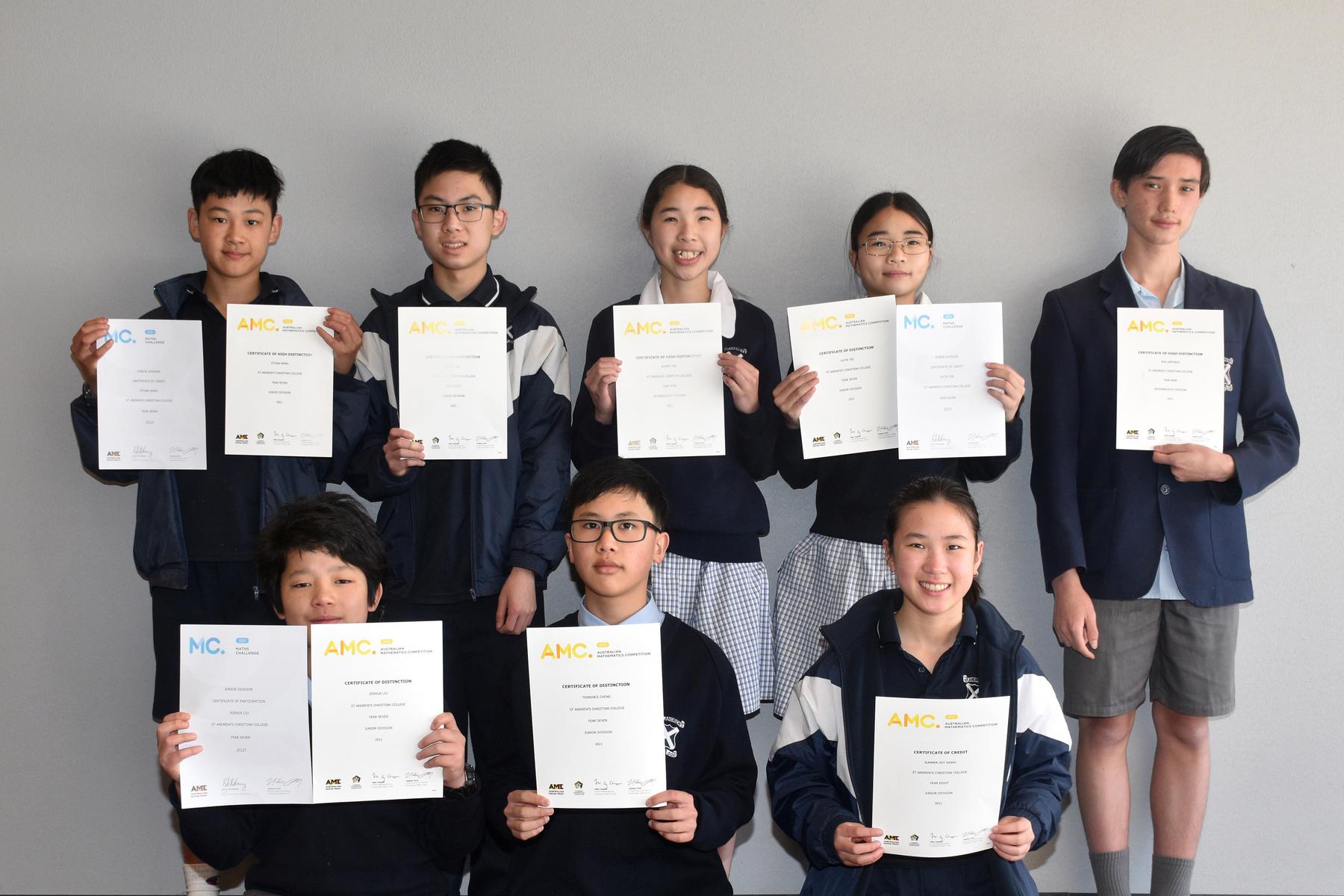LEARNING AND TEACHING

Learning Support at St Andrews
We thank God for many things as we journey through Term 4. Our Learning Support Team recently brainstormed and made a list of all the things that they are thankful for:
Our team has had the privilege of coming to school each day, working together and alongside students during lockdown. As we begin to transition back to students being on campus, we are mindful that this is difficult and overwhelming for some while being a joyous and exciting return for others. We are very aware that we all need to make adjustments as we return and to give grace as we encounter others who may be struggling.
In Week 1 this term, we ran our second ‘Autism Spectrum Parent Support Group’. Again, this needed to be done online, but it was wonderful to chat together about how online learning was progressing for them as well as discuss strategies that may be helpful as we prepared for the return to school. Our prayer is that we will be able to have a face-to-face meeting next time. If you have a child on the spectrum and would like to be part of this group, you are most welcome. Emails about upcoming meetings are sent to all parents.
Some helpful hints that may be helpful with the return to school:
- Support understanding through use of social stories/scripts, clear direct language, visual support for new rules - days attending, times attending, changes to the drop off and pick up etc.
- Be aware of changing behaviours.
- Communicate with the class teacher if you have questions or concerns.
Here are a few websites that we shared at the last meeting:
Autism SpectrumPositive PartnershipsAmaze
You are always welcome to contact one of the Learning Support teachers:
- Shirley Gillie – Head of Learning Support sgillie@standrews.vic.edu.au
- Wendy Punay – Learning Support Teacher – Primary wpunay@standrews.vic.edu.au
- Kerryn Terrington – Learning Support Teacher – Secondary kterrington@standrews.vic.edu.au
Blessings
The Learning Support Teachers
Academic Competitions
Academic Competition involvement has always been strong at St Andrews Christian College and, despite the challenges of completing these competitions online, many students across the College have again participated in the Australian Mathematics Competition (AMC), The Maths Challenge or one or more of the ICAS AssessmentsTM. Congratulations to all students who participated and well done to those who received special awards.
Australian Mathematics Competition (AMC)
A total of 99 students from Year 3 right through to Year 12 competed in the Australian Mathematics Competition. Prizes are awarded to students who score in the top 0.3% of the State, High Distinctions to the top 3% (or top 5% for Senior level), Distinctions to the top 20% and Credits to the top 55%.
The table below summarises the excellent achievement of our students:
Prize | High Distinction | Distinction | Credit | Total Entries | |
| Year 3 – Middle Primary |
| 3 | 7 | 9 | 21 |
| Year 4 – Middle Primary | 1 | 2 | 8 | 8 | 19 |
| Year 5 – Upper Primary |
|
| 7 | 10 | 19 |
| Year 6 – Upper Primary |
| 1 | 4 | 7 | 13 |
| Year 7 - Junior |
| 1 | 4 | 4 | 12 |
| Year 8 – Junior | 1 |
| 1 | 2 | 8 |
| Year 9 – Intermediate |
| 2 |
| 2 | 4 |
| Year 10 – Intermediate |
|
|
| 2 | 2 |
| Year 12 – Senior |
| 1 |
|
| 1 |
Congratulations to the following students who received either a Prize, High Distinction or Distinction:
Prize:
Year 4: Junru Teng
Year 8: Matthew Wu
High Distinction:
Year 3: Elliott Wong, Elizabeth Chong, Isabella Yin
Year 4: Zara Lim, Jiamiao Liu
Year 6: Zachary Lim
Year 7: Ethan Wang
Year 9: Summy Yee, Max Demunck
Year 12: Jiapeng Liu
Distinction:
Year 3: Shiphrah Wang, Samuel Tang, Ledison Chan, Gabriel Fong, Jordan Nah, Joyce Zhao, Jett Wong
Year 4: Akesh Weerakoon, Jayden Yang, Sarina Tang, Chris Mei, Calamus Chan, Jason Kiswoto, Charlotte Cheung, Keyvas Ng
Year 5: Marcus Chong, Gabriel Liu, Zijin Wang, Joshua Chen, Angela He, Eric Li, Sheanne Hii
Year 6: Lucas Chen, Ethan Loke, Andrew Muggeridge, Cleve Xi
Year 7: Terrence Cheng, Katie Yee, Joshua Liu, Sean Ortega
Year 8: Joash Law
Mathematics Challenge for Young Australians
Run by the Australian Mathematics Trust, the Maths Challenge is a problem-solving activity aimed at stimulating the mathematically interested students in their year level. The problems are challenging and require time and persistence, but are based on mathematics that should be known at that level. Students in the Junior (Year 7 and 8) level may work with a partner who has also entered the Challenge, while students in the Primary levels may work in groups of up to three. Separate solutions must be submitted by each student. Congratulations to the 11 students from Year 5 and 6 and the 12 students from Year 7 who participated in the Maths Challenge.
Congratulations to the following students who achieved Distinction and Credit Awards:
Distinction
Year 6: Naomi Law
Year 7: Annika Li
Credit
Year 6: Sherry Che, Ethan Loke, Tobias Setiawan, Lucas Chen, Zachary Lim, Andrew Muggeridge
Year 7: Ethan Wang, Katie Yee
ICAS
Over the last few weeks a large number of St Andrews students have participated in the ICAS Academic Competitions. ICAS AssessmentsTM are designed to recognise academic excellence. Students are assessed on their ability to apply classroom learning to new contexts, using higher-order thinking and problem-solving skills. Students have participated in tests for the following areas: Digital Technologies, English, Science and Spelling Bee. This year we have had 87 students in the Primary School (Year 2 – Year 6) complete 275 tests and 34 students in the Secondary School (Year 7 – Year 10) complete 86 tests. Results will be available later in the year.
Michael Swanborough
Head of Learning and Teaching
Mathematical Problem Solving –
The problem DICE FOOTY from the last Newsletter was as follows:
Given that we are in the midst of the AFL Football Finals, an activity which you might like to try as a family is the game of dice footy.
Take a standard six-sided dice and use this to simulate a football game. The first roll of the dice is the number of goals scored in the quarter and the second dice roll is the number of behinds. The total score for the quarter is found by multiplying the number of goals by 6 (6 points for a goal) and then adding the number of behinds. Record your scores for each quarter and see who wins the game.
An example is as follows:
Player 1 |
|
|
| Player 2 | |||||
Goals | Behinds | Points |
|
|
| Goals | Behinds | Points | |
| Q1 | 4 | 2 | 26 |
|
| Q1 | 3 | 5 | 23 |
| Q2 | 2 | 6 | 18 |
|
| Q2 | 4 | 1 | 25 |
| Q3 | 5 | 4 | 34 |
|
| Q3 | 2 | 3 | 15 |
| Q4 | 6 | 1 | 37 |
|
| Q4 | 6 | 5 | 41 |
| Total | 17 | 13 | 115 |
|
| Total | 15 | 14 | 104 |
You might like to play a “season” and record the scores after each round. Even play a finals series and see which team wins.
A mathematician might be interested in a range of different questions about the scores.
a) What is the maximum score possible?
b) What is the minimum score possible?
c) What is the expected, or average, score per game?
d) What are the chances of the game being a draw?
e) If my opponent has had their turn in the last quarter and is now 22 points ahead, what are my chances of winning?
f) What is the chance of me scoring at least 15 goals, 18 goals, 20 goals…?
g) How many games would you have to play to score the “maximum” score possible?
What other investigations might be possible?
Solutions:
a) The maximum possible score is 24 goals, 24 behinds for a Total of 168 points.
b) The minimum score possible is 4 goals, 4 behinds for a Total of 28 points.
c) The numbers 1, 2, 3, 4, 5 and 6 all have the same chance of occurring. So, over six typical games they will all occur once. Hence, the average would be (1+2+3+4. So, in any one quarter the average score expected would be 3.5 goals, 3.5 behinds for a Total of 24.5 points. Over the course of the four quarters in the game, the expected score would be four times this amount. Hence, 14 goals, 14 behinds for a Total of 98 points.
d) The chances of a draw are quite complicated to calculate as it depends on the score you are chasing in the last roll. See part e) below for one possible example.
e) Using a systematic list, the possible options for me to roll are as follows:
| Goals | Behinds | Comment |
| 6 | 1, 2, 3, 4, 5, 6 | Any of these will mean I win |
| 5 | 1, 2, 3, 4, 5, 6 | Any of these will mean I win |
| 4 | 1, 2, 3, 4, 5, 6 | Any of these will mean I win |
| 3 | 5, 6 | Any of these will mean I win |
| 3 | 4 | This would be a draw |
| 3 | 1, 2, 3 | Any of these will mean I lose |
| 2 | 1, 2, 3, 4, 5, 6 | Any of these will mean I lose |
| 1 | 1, 2, 3, 4, 5, 6 | Any of these will mean I lose |
Out of the 36 possible scores, 20 of them will result in a win. Therefore, my chances of winning are “20 out of 36” or 55.6%.
f) This type of question requires some complex thinking – or a computer simulator which can run multiple games.
The chance of rolling a six (for goals) in the first quarter is one chance in six.
And of rolling another six goals in the second quarter – one chance in 36.
And of rolling another six goals in the third quarter – one chance in 216.
And of six in all four quarters – one chance in 1296.
If we wanted to know the chances of scoring exactly 23 goals, this would mean scoring three 6’s and one 5. But the single 5 could occur in any quarter, so the chances are 4 in 1296 or once every 324 games.
Similarly, to score 22 goals, this could be as three 6’s and a four, or two 6’s and two 5’s. the first option can occur in four different ways (the 4 cold be in any quarter), the second option can occur in six different ways: (6, 6, 5, 5)… (6, 5, 6, 5)… (6, 5, 5, 6)……. (5, 5, 6, 6). This results in ten chances out of 1296 or once every 129.6 games.
g) To score the “maximum” of 24 goals, 24 behinds = 168 points, we would have to score 6 goals, 6 behinds in each quarter. There is one chance in 36 of achieving this score.
To do this four times in a row is one chance in 36 x 36 x 36 x 36 or one in 1 679 616.
So, we would need to play over one and a half million games to get one “maximum score.”
One major conclusion which can be drawn from this activity is how much mathematics can be discovered even in a simple situation such as a dice game. It also emphasises how a mathematician goes about first recognising interesting questions or observations and then how they use their toolbox of skills and strategies to collect and analyse data.
I hope you, too, found some interesting questions to ponder from this activity.
Michael Swanborough
Head of Learning and Teaching





